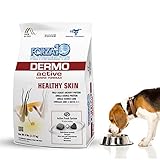5 Best dog food for labradoodle with allergies
Table of Contents
The Labradoodle is a hybrid breed between a Labrador Retriever and a Poodle of any breed. Labradoodles are best friends for pet lovers, with their limitless activity and charming curled hair.
They are loyal, sociable, and high-energetic dogs, but they need to eat a proper diet to stay healthy and happy.
As a Labradoodle owner, you should always need to keep a close eye on your pet’s eating habits because they eat anything around the insight. As a result, your Labradoodle dog may develop many skin and stomach allergies, leading to significant health issues and, in extreme cases leading to death.
| Image | Title | Prime | Buy |
|---|---|---|---|
 | Purina Pro Plan Sensitive Skin and Stomach Dog Food With Probiotics for Dogs, Salmon & Rice Formula - 30 lb. Bag | Prime | Check Price |
 | Ps for Dogs 100% Hypoallergenic Dog Food - No More Paw Licking & Skin Scratching – Solves Allergies Naturally - No More Harmful Shots, Pills & Expensive Prescription Food | PrimeEligible | Check Price |
 | Hill's Science Diet Dry Dog Food, Adult, Sensitive Stomach & Skin, Chicken Recipe, 30 Lb Bag | PrimeEligible | Check Price |
 | Lucy Pet Products Formulas for Life - Sensitive Stomach & Skin Dry Dog Food, All Breeds & Life Stages - Duck, Pumpkin, and Quinoa, 25 lb, Model:850657006500 | PrimeEligible | Check Price |
 | Forza10 Dermo Allergy Dog Food, Dog Food for Allergies and Itching, Dog Food for Skin Allergies, Fish Flavor Sensitive Stomach Dog Food, Adult Dogs All Breeds, 6 Pounds | PrimeEligible | Check Price |
To live a healthy life, your Labradoodle requires a high-quality, well-balanced diet. For a strong immune system, coat, skin, and health, your dog’s diet should be balanced and natural.
Labradoodles rely on their kibble to provide them with crucial vitamins and nutrients for their healthy growth and development.
If your Labradoodle dog is already suffering from allergy issues, you need to feed your dog the best dog food for Labradoodles with allergies that meet all the nutritional requirements to keep them healthy.

What are some common Types of Allergies in Labradoodle?
Labradoodle allergies are incredibly prevalent, and your dog is susceptible to induce allergies at least yearly. Do you notice itching, diarrhea, hives, or inflamed skin in your dog? All these symptoms could indicate that your Labradoodle has allergies.
Allergies develop when a dog responds to substances in its atmosphere that are typically nontoxic to other canines. This happens when the immune system of your dog is oversensitive. Histamines are released when a dog’s body attacks these innocuous compounds. Consequently, skin swelling, irritation, and redness, causing to your dog.
The top 3 Labradoodle Allergies are listed below, along with information on how to treat and avoid them.
1. Skin Allergies in Labradoodles
Skin allergies are the most frequent type of dog allergy in Labradoodles, but they can also be the most difficult to diagnose. Allergic dermatitis, often known as skin Labradoodle allergies, is caused by three main factors:
- Flea allergies
- Food allergies
- Environmental allergies.
Allergies in Labradoodles should be handled seriously; like humans, dogs can experience anaphylactic shock, which can be fatal if not treated appropriately. If you detect any swelling in your dog’s face, neck, lips, or eyelids, consult your veterinarian for an antihistamine treatment.
2. Fleas Allergies in Labradoodle
Labradoodles have a lot of hair, which attracts dirt and bugs, including fleas. In most cases, an owner only finds fleas when their dog starts itching. Flea allergies are allergic reactions to flea saliva. Whenever a flea bites your Labradoodle, it injects saliva into your dog, causing irritation and allergic reactions.
An allergic flea bite causes extreme itching that lasts far longer than a regular flea bite. Common Symptoms include a rash, raw and exposed skin, raised lumps, and prolonged bleeding. Keep a watch on your dog’s legs, tummy, and tail for flea bites.
3. Food Allergies in Labradoodle
Labradoodle’s prevalent many food allergies that include allergies from specific food ingredients like beef, lamb, chicken, eggs, corn, wheat, and milk.
Labradoodle food allergies cannot only cause irritation and itchy skin, but they can also cause gastrointestinal issues such as diarrhea and vomiting.
4. Environmental Allergies in Labradoodle
Labrador Dogs can also be allergic to their surrounding environment. Things like dust, mold, and pollen can cause topical skin allergies in your dog. Some common symptoms of environmental allergies in Labradoddle include dog sneezing, red eyes, and water discharge from one eye.
How to Treat the Labradoodle Dog Allergies?
- You should take your Labradoodle to your veterinarian if you detect allergy symptoms since allergy is likely to be infected by constant scratching and biting.
- Your veterinarian will change your dog’s flea medicines and defines the limit of your dogs’ exposure to the outside environment.
- Typical treatment of allergies includes New flea medicines, and spot-treatment flea medicines might also treat that allergy.
- All carpeted areas will also be cleaned to avoid spreading fleas. Furthermore, your veterinarian may suggest topical or injectable treatment to reduce inflammation and itching for your Labradoodle.
- Some allergy treatments would be similar to Benadryl treatment. If the Labradoodle skin is exposed, causing the infection of skin allergies, then sometimes Vetnary doctors prescribe antibiotics for skin allergy treatment.
What are the Vital Nutritional Requirements of Labradoodle?
A complete, balanced meal with all vital nutrients is required for dogs, regardless of their breed, and this is also applied to Labradoodles. High-quality protein, carbs, fat, fiber, vitamins, and some minerals are included in their diet to strengthen their immune system.
Following are some essential dietary elements of Labradoodle food to strengthen their immune system and prevent them from various types of allergies.
- Protein
The most crucial component in dog food formulations is chicken, beef, and fish, containing a significant portion of proteins. When Labradoodle pups are in the growing stage, their muscles need an adequate amount of protein to grow healthy.
Puppies and adult Labradoodles are supposed to obtain at least 22% protein in their diet, according to the AAFCO Nutrient Requirement for Dogs.
- Carbohydrates
Good quality carbs are also another vital element of Doodle’s health. The best dog food for labradoodle contains grains that are more processed and have more fiber than other nutrients.
Many Labradoodle owners choose grain-free dog foods, even though grains are not harmful to dogs. If your labradoodle is allergic to a specific type of grain because of his food allergy, primarily the real culprit is grains like wheat and soy.
- Fats
Fats, like carbs, are another critical nutritional element that Labradoodles should require. Feeding your Labradoodle Omega-3 fatty acids helps your pet to live healthily. Fatty acids help your dog’s stomach to absorb other nutrients easily.
They also help to relieve the health issues related to their hair, skin, eyes, and other internal organs.8% fat is required to develop and reproduce adult dogs.
- Other vital elements of Labradoodle food
The following are some other vital elements in dog food include:
- Calcium
- Magnesium
- Potassium
- Sodium
- Iron
- Zinc
- Taurine
- Glucosamine
- folic acid
- Vitamins A, B, C, D, E, K.

Best Dog Food For Labradoodle With Allergies
Following are some recommended formulas for Labradoodles if they are suffering from Allergy issues.
1. Purina Pro Plan for Sensitive Skin & stomach
The Purina Pro Plan recipe provides complete & balanced nutrition for the maintenance of adult dogs. This formula is AAFCO approved dog food formula.
Purina Pro Plan Sensitive Skin & Stomach Formula with Salmon fish & Rice For Adult Dogs provides complete and balanced nutrition for the overall growth of adult dogs.
The first ingredient in this formula is salmon fish. Although salmon contains protein and omega-3 fatty acids, raw salmon contains more than 60% moisture. After cooking, the relative meat contribution of salmon is dramatically reduced for making dog food.
The second ingredient is barley which contains nutritious carbohydrates and is naturally rich in dietary fiber and various minerals that are very beneficial for a dog’s good health.
The third ingredient is rice. Rice is a gluten-free carbohydrate source. Rice can also provide a good amount of fiber and nutrition to dogs.
The fourth ingredient is oatmeal. Oatmeal is rich in dietary fiber and contains vitamins B and various minerals.
The sixth ingredient in the Purina Pro Plan Salmon & Rice Formula For Adult Dogs is a Canola meal that is a high protein source obtained by-product of canola oil production and may be derived from genetically modified seed. The remaining ingredients are not as essential as the first six, but collectively they still have a significant effect on the quality of the product.
Ingredients
- Carbohydrate 38.00 % (43.18 %)
- Moisture (max) 12.00 % (0.00 %)
- Crude Fiber (max)4.00 % (4.55 %)
- Crude Fat (min) 16.00 % (18.18 %)
- Crude Protein (min) 26.00 % (29.55 %)
Final Verdict
Purina Pro Plan dog food contains active probiotics to help to strengthen your dog’s immune and digestive systems. If your Labbradoddel is suffering from skin and stomach issues, the salmon fish oil contains in that formula helps to reduce the skin and allergy problems and improves the overall health of the coat.
2. Ps for Dogs 100% Hypoallergenic Dog Food
- REDUCES PAW LICKING: Our low glycemic dog allergy food prevents the growth of yeast on your dogs paws, which is the leading cause of paw licking and biting in dogs today
- SOLVES SKIN ITCHING, REDNESS, BUMPS AND FOUL ODOR: Our limited ingredient formula contains human-grade New Zealand Lamb and other essential hypoallergenic ingredients; which will relieve your dogs skin problems
- GRAIN FREE, HIGH PROTEIN AND SUPER ADDICTIVE: Our recipe was created especially for dogs who are fussy about their food, who need a grain free or high protein diet. PS is air-dried; creating soft irresistible pieces of meaty goodness; perfect as a hypoallergenic tr
PS for Dog food offers a formula that is designed mainly for dogs that have skin and food allergies; according to the PS brand, this formula is made with few ingredients and no grains. This formula encourages proper digestion while also reducing itching and licking caused by allergy-related discomforts in your dogs.
This formula contains real meat pieces of Australian lamb that are completely air-dried and some other hypoallergenic ingredients to provide high amounts of protein to Labradoodle dogs with skin allergies.
It also helps to control smelly, foul produced by the stomach, allergies, as well as the improvement of your dog’s coat. Dogs that are fussy eaters and demand to eat a high protein and grain-free diet are highly recommended to eat that food with a greater appetite can benefit from this meal.
The low glycemic dog food content in that formula prevents the labradoodle from the growth of yeast infections in the dog’s body. These yeast infections, if not controlled by the food lead to paw licking and biting in Labbradoddle.
Ingredients
The manufacturer does not define the ingredients of that formula, but authentic lamb meat pieces are the primary source of protein in that formula.
Final Verdict
PS 100% dog food is the best dog food for labradoodle with skin allergies. This dog food is best for dog owners searching for natural food formulas to prevent dog stomach and skin allergies. This natural dog food helps to reduce yeast infections and the licking and biting of dogs by adding natural and hypoallergenic ingredients to dog food.
3. Hill’s Science Diet Dry Dog Food
The hills science dog food formula contains ingredients that are beneficial for dogs’ sensitive skin and stomach issues.
The 5 Most Important Ingredients in this formula are given below:
Chicken: is a healthy element included in that formula that provides a good quantity of protein, fat, and other nutrients.
The water content of raw meat is around 75%, which is boiled off during dog food production. Only a small portion of the protein content remains in the final product weight.
Brewers Rice is the second most: crucial element of that dog food formula. Brewer’s rice is made up of tiny, broken white rice pieces left behind after rice is milled. It’s utilized in that formula that helps to sting the dog’s stomach.
Chicken meal is the third vital element of that formula. To make a protein-rich meal powder, water is removed from chicken meals. Chicken meals include roughly four times the protein of the meat. Chicken meal is a good source of protein for dogs.
Yellow peas are high in carbohydrates, fiber, and protein. Peas are rich in phosphorus, magnesium, copper, iron, zinc, vitamin A, vitamin B6, vitamin C, and vitamin K. These elements include dog food, which also helps to stronger the healthy immune function.
Barley is a cereal grain that provides calories and a variety of nutrients such as protein, dietary fiber, B vitamins, niacin, and other minerals. For dogs, barley provides carbohydrates, energy, fiber, and other essential elements. In general, barley is a nutritious dog food component that helps to digest fiber.
Ingredients
- Min. Protein 23.60%
- Min. Fat 15.20%
- Min. Carbs 54.20%
- Max. Fiber 1.60%
- Max. Ash 7.00%
- Max. Moisture 0.00%
Final Verdict
Hill science dog food is a high-quality formula specially manufactured for sensitive stomach and skin problems in dogs. The primary source of protein in this formula is chicken meat added after processing to reduce the skin allergy effects on the dog. This formula also contains probiotic supplements to improve gut health and the overall immune system.
4. Lucy Pet Products Formulas
Lucy pet food is specially formulated to solve the gut health and stomach issues of dogs. This dog food formula contains anti-oxidants that help to strengthen the dog’s immunity. Dr. Fahey, a leading veterinary dog specialist, also recommends this dog food.
This food formula contains natural ducks sourced from France that are an excellent source to provide protein for dogs, keep their muscles healthy, and improve their skin and coat.
This dog food formula is formulated to nourish the overall health issues of the dogs, and its primary focus is to maintain the gut health of the dogs which leads to overall health.
The omega-three and the natural fatty acids include in that formula help to improve coat health and shine and help to reduce many types of skin allergies in dogs.
This formula also contains food supplements and elements of Taurine and L-Carnitine that are beneficial for the healthy heart of the dogs and relieve the dog’s stress.
Prebiotic balanced fiber elements contained in that formula help to maintain the gut health of the dogs. Each food packet is designed to keep in mind the nutritional needs of all ages of dogs of different kinds of breeds.
It cannot contain corn, wheat, soy, artificial colors, preservatives, and flavor.
Ingredients
- Crude protein 25. 0%
- Minimum crude fat 14. 0%
- Minimum crude fiber 6. 0%
- Maximum moisture 10. 0%
- maximum zinc 110 ppm omega-3 fatty acids*
- 3%omega-6 fatty acids*
- 0% aafco dog food nutrient profiles
Final Verdict
Dog food is produced in the United States and includes duck protein sources for dogs. Lucy dog food is an excellent alternative for reducing your dog’s allergies. This dog food provides the necessary elements, nutrients, and fatty acids essential for the dog’s health and coat. The probiotics supplement in that dog food helps to maintain the gut health of the dog.
5. Forza10 Dermo Sensitive Skin
- ALLERGY DOG FOOD - specially formulated dry dog food helps improve dry skin and provides relief for minor skin ailments and allergies for sensitive skin, while promoting overall dog health and wellness.
- DOG FOOD FOR ALLERGIES AND ITCHING - rich in raw fish proteins, fiber, and omega 3 fatty acid. Grain free dog food sensitive stomach that contains no GMOs, no gluten, no artificial colors or flavors.
- HYDROLYZED DOG FOOD - dog food for coat contains hydrolyzed fish protein so the immune system wont react and help with food allergy and inflammatory bowel disea
Forza was a research development team with 30 veterinary researchers who research pet food and now become a dog food brand. The Forza 10 dry food formula is specially formulated for solving dry skin problems in dogs.
This formula helps to relieve the dry skin issues of Labradoodles and helps to solve sensitive skin issues by building a healthy immune system for dogs.
The main ingredient of this dog food is hydrolyzed fish which is very effective.
If your Labradoodle contains stomach allergies, then hydrolyzed meat cannot react on the stomach and cannot affect bowel disease and build a healthy immune system.
This food formula is enriched with Icelandic wild-caught anchovy, which will satisfy the taste buds of your dog even if he is a fussy eater. Natural extracts of papaya, pomegranate, and Aloe Vera are beneficial in dog skin inflammatory problems.
This formula contains a healthy amount of omega-three and six fatty acids that help to build a strong immune system. You can use food formula for your labradoodle dog if he continues sensitive skin issues, and you cannot need to consult any vetneary doctor for giving this feed because this feed is formulated under the consultation of great veterinary nutritionists.
After using this food formula, you will find the results in only seven days. This formula cannot contain any type of grains like wheat, soy, and corn.
Ingredients
- Protein: 30%
- Fat: 15.6%
- Fiber 3.7%
Final Verdict
This food formula is specially formulated to handle the dry skin issues of the dogs. If your labradoodle dog is facing dry and sensitive skin, this dog food is ideal. You cannot need any prescription for giving this food. This dog food solves all the skin problems and digestive issues and makes the coated skin beautiful.
How to choose the best dog food with Allergies for Labradoodle
The best dog food for Labradoodles was chosen depending on a lot of considerations. No two Labradoodles are the same, and no two dog meals are alike. Here are some things I strongly recommend you when choosing the best dog food for Labradoodle with allergies.
· Choose a balanced diet formula.
Although all-natural dog food is considered best, before buying, you must ensure that the dog food formula contains a balanced diet for your Labradoodle. Remember that dogs still require proteins, fats, and carbs, so you should be considered the components that indicate a well-balanced diet for your Labradoodle.
· Observe Your Dog’s Nutritional Needs
Always Keep in mind that your dog’s needs may differ from your neighbor’s dog. So, You should select a formula that is appropriate for your Labradoodle’s size and health requirements. Many dog formulas are formulated for different sizes of dogs.
· Consider your dog size and age.
At the time of selecting an appropriate formula, consider your dog size and age. If your Labradoodle is a medium to large dog, you need to choose a good formula that fulfills the nutritional requirements of adult dogs. If your Labradoodle is small size puppy, then choose a small breed dog food.
Because formulas are made according to the dog’s age and weight, that helps to maintain the dog’s healthy weight.
Consider Allergies and stomach issues.
If your Labradoodle is inclined towards food sensitivities, such as allergies or stomach sensitivities, you’ll need to be highly alert while selecting dog food for him. A sensitive skin formula may be required for dogs with sensitive skin. Some substances may trigger reactions in them, such as itching or scratching.
If your Labradoodle dog has a history of gastrointestinal sensitivity, you may need to switch them to a portion of limited-ingredient dog food gradually. Don’t expect your Labradoodle to adjust to a new diet in a single day. To minimize negative responses, most healthy dog meals require your dog to adjust over some time.
- Levels of Activity & Age
Finally, consider your dog’s age and level of activities. There are numerous stages in a dog’s life, and each stage may require a different balance and nutritional requirements.
This is because dietary requirements vary based on the type of exercise your dog participates in and the type of activity they are likely to perform.
Frequently Asked Questions
1. How Much Do I Feed My Labradoodle?
1 to 2.5 cups of high-quality dry food per day is the recommended daily quantity of food for your Labradoodle. Feedings should be divided into two halves. This will reduce bloating risks. Two small meals each day instead of one large one can reduce gastric intensional problems.
2. How to Choose the Best Dog Food for Labradoodles?
You need to pick a dog food for your Labradoodle based on its size, weight, and nutritional requirements. In general, you’ll need to buy a portion of dog food that doesn’t contain fillers like corn, soy, or wheat. Best dog food for Labradoodles contains All-natural ingredients with real meat.
3. Do Labradoodles need special food?
Labradoodles, like other dogs, require a balanced diet that contains a wide range of food and other nutrients. The best Labradoodle dog food contains high-quality protein, carbs, and a small amount of fat, fiber, vitamins, and minerals.
4. Does Labradoodle have stomach issues?
Labradoodles are known for being hoover for eating leftovers and spilled food. This puts them in danger of not only getting a foreign body lodged in their intestines but also ingesting something that will make them sick. They are also prone to food allergies.
5. What are the signs of a sensitive stomach in Labradoodle?
There are many signs of a sensitive stomach like:
- Vomiting
- Diarrhea
- Mucus in the stool
- Flatulence
- Bloating
- Constipation
- Weight Loss
- Stomach Cramps
6. How much is my Labradoodle weight in adulthood?
Labradoodles are a hybrid dog breed with a wide range of sizes depending on their genealogy. Adult Labradoodles generally weigh over 45 pounds, with some weighing up to 100 pounds, according to Agape Labradoodles. Most Labradoodles will contains weights between 50 and 90 pounds.
Conclusion:
Labradoodles come in a variety of sizes, including small, medium, and standard. They also have hypoallergenic and non-shedding coats that require additional nutrients to keep them soft. You must select a dog food for your Labradoodle based on its size, weight, and nutritional requirements.
You need to buy dog food that doesn’t contain fillers like corn, soy, or wheat. All-natural ingredients with real meat are found in the best dog food for Labradoodles with allergies. This food also helps to maintain the active labradoodle lifestyle with a lot of exercises. I hope now you can find the best food for your dog!
References:
- 1xbet официального Сайт Казино Игровыми Автоматами 1хбет - April 17, 2024
- Бездепозитные Бонусы За Регистрацию и Онлайн Казино 202 - April 9, 2024
- Yeni Deneme Bonusu Veren On Line Casino Siteler - January 31, 2024












